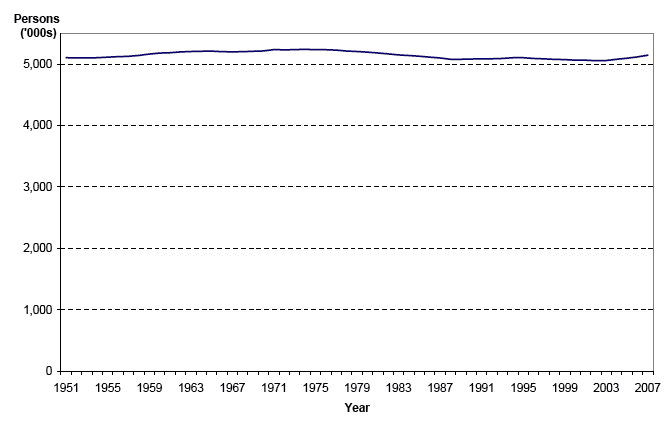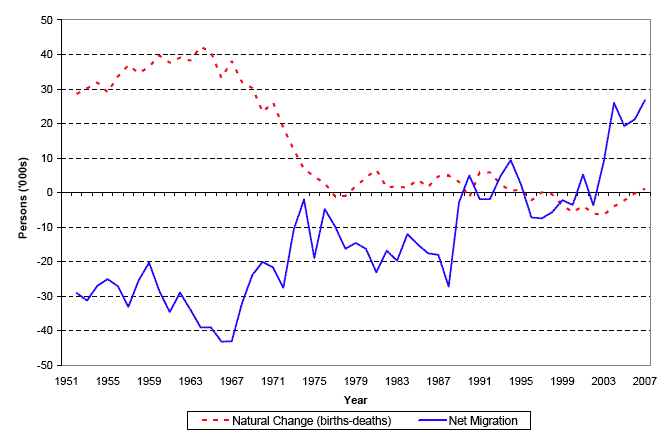
2.1 The estimated population of Scotland on 30 June 2007 was 5,144,200 – the highest since 1983. The increase of 27,300 on the previous year was the biggest single year increase since 1946-47. There are almost 90,000 more people in Scotland than in 2002, when the population hit its lowest level since just after the Second World War. In the twelve months to mid-2007, there was a net migration gain of 26,800, the largest level recorded since current records started in 1952. This consisted of a net gain of 8,800 people from the rest of the UK, a net gain of 16,800 from overseas (including asylum seekers) and a net gain of 1,200 due to movements to and from the armed forces. Other changes (including changes in the prison population, and changes in the number of armed forces stationed in Scotland) amounted to a decrease of 600 people. Compared with the previous year there were more births (+3.2 per cent) and slightly more deaths (+0.7 per cent). The number of births in the twelve months up to mid-2007 exceeded the number of deaths by 1,100. The last time that births exceeded deaths in Scotland was in 1996-97. In 2005-06 there were around 300 more deaths than births.
2.2 This is the fifth year in a row that the Scottish population has increased and this recent increase has been largely a result of more people migrating into Scotland than leaving. In 2006-07 around 51,500 people came to Scotland from England, Wales and Northern Ireland and 42,700 left Scotland to go in the opposite direction. The resulting net inflow of 8,800 was very similar to the previous year’s 8,900 net inflow although around 1,800 fewer people moved in each direction.
2.3 The overseas net gain of 16,800 came from an inflow of 37,800 and an outflow of 21,000. This record net gain from overseas compares to a net inflow of 12,700 the previous year which was itself a record. The difference is a result of fewer people leaving Scotland to go overseas despite slightly fewer people moving in the other direction. Estimating international migration is particularly difficult. The estimate is based primarily on the International Passenger Survey (IPS) which is a sample survey conducted at main airports and ports across the UK. The sample size for Scotland is very small with around 180 contacts in 2006-07. Internationally, a migrant is defined as someone who changes their country of usual residence for 12 months or more, so a short-term seasonal migrant worker will not be counted in the migration estimates or in the mid-year population estimates. More details about the migration data sources and definitions used can be found in Section 6.
2.4 For comparison purposes it is better to look at a time frame of longer than one year, as population change tends to fluctuate from year to year, particularly for smaller areas. Between mid-2001 and mid-2007, Scotland’s population increased by 1.6 per cent (+80,000) from 5.06 million to 5.14 million (Table 6). Over the last 10 years, between mid-1997 and mid-2007, Scotland’s population increased by 1.2 per cent (+60,860) from 5.08 million (Table 7 and Figure 1). As shown by Figure 2, the main reason for the smaller increase over the longer period is that there was a negative net migration for the early years of the period 1997-2007. Natural change (births minus deaths) was also negative for most of this period.
Figure 1 Estimated population of Scotland, 1951-2007

Figure 2 Natural change and net migration, 1951-2007

2.5 Table 9 shows movements to and from the UK and overseas between mid-2006 and mid-2007 by age group. The main source of data for the overseas migration calculations is the International Passenger Survey and as the sample size is small for Scotland (about 180) an age and sex distribution is assumed using information about General Practitioner (GP) registrations. The method used to estimate international migration is described in Section 6.
2.6 Migrants tend to be younger than the general population. Of in-migrants to Scotland, 46 per cent of those from the rest of the UK and 68 per cent of those from overseas were aged 16-34 years, compared with 24 per cent of the resident population for this age group. Only 5 per cent of people coming to Scotland from the rest of the UK were aged 65 and over.